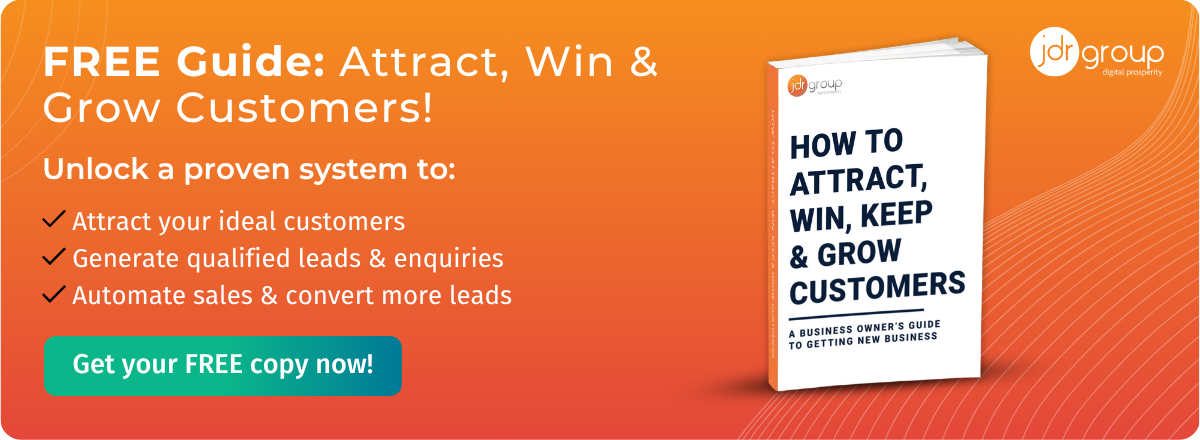B2B Marketing Explained: Definition, Strategies, Tips & Tools To Use
by Will Williamson on 14-May-2025 12:30:00

If you’re a business that sells to other businesses, not consumers, then you’re doing B2B marketing. And that changes how you approach everything, from your messaging to how long it takes to close a deal.
Unlike B2C (business-to-consumer) marketing, which often plays on emotion or impulse, B2B is more about logic, trust, and results. Your buyers are making bigger decisions with more people involved, so your marketing needs to be smarter, clearer, and focused on solving real business problems.
This guide will walk you through the basics, what B2B marketing actually means, how it’s different from B2C, and how to create a strategy that gets results.
You’ll learn:
- How to define and understand your ideal business customer.
- Best marketing tactics (like SEO, content, email, and LinkedIn).
- The tools that can save you time and improve your results.
- Practical tips and examples to help you get started.
What Is B2B Marketing?
B2B (business-to-business) marketing focuses on selling products or services to other businesses. It’s less about quick wins and more about building long-term relationships and showing value. Sales often take longer and involve multiple decision-makers, so trust, transparency, and solid information are key. Buyers want to know how your solution will help their business grow, save money, or solve a specific challenge.
Main Differences Between B2B and B2C Marketing
When you're marketing to other businesses instead of consumers, your approach needs to shift in several key ways:
- Your Buyers: You're talking to decision-makers, often a team of them, rather than individual shoppers.
- How They Buy: B2B sales usually involve longer, more complex buying processes, with more research, discussions, and approvals.
- What Matters to Them: B2B buyers care about logic, results, and ROI. They're focused on solving problems and improving business outcomes.
- How You Communicate: Your messaging should be clear, detailed, and focused on value, less flash, more facts.
Understanding these differences helps you align your marketing with what business buyers actually need, making your efforts more effective and relevant.
Getting to Know Your Business Audience
To market effectively, you need to understand exactly who you’re trying to reach and what matters most to them. In B2B, purchases are rarely made by just one person. Often, several stakeholders are involved, each with their own concerns. That’s why your message needs to speak to all of them.
Here’s how to dig deeper into your audience:
- Industry Focus: Tailor your messaging based on the unique challenges of the industries you serve.
- Company Size: A small business and a large enterprise may face very different issues and respond to different solutions.
- Who’s Involved, aka Decision-Makers: Figure out which roles (like CEOs, department heads, or procurement managers) influence buying decisions.
- Their Pain Points: Know what problems they’re trying to solve, like cutting costs, saving time, or staying compliant.
- What They Use Now: If you understand their current tools or suppliers, you can position your offer as a better alternative.
Creating detailed buyer personas (profiles of your ideal business customers) helps you craft messages that truly resonate. Instead of guessing what to say, you’ll speak directly to what your audience cares about.
The better you understand your audience, the more effective your marketing will be, from first impression to final sale. This leads to stronger engagement, greater trust, and higher conversions, positioning your brand as the right choice at every stage of the buying journey.
Creating a B2B Marketing Strategy
In order to create an effective B2B marketing strategy, you need to think differently than you would for B2C. Business buyers take their time, weigh options carefully, and want to see exactly how your product or service solves a problem or improves their bottom line.
To reach them, you need a multi-channel approach. No single tactic works on its own. Content marketing, SEO, email, and social media all play a part, each helping you educate potential clients, build trust, and move them closer to a buying decision.
With a practical, results-focused B2B marketing plan, you can use the right digital strategies to attract high-quality leads and grow your business. Here’s what you can implement:
Content Marketing
Good content builds trust. Instead of selling, focus on educating and solving problems.
- Case Studies: Show real results from real clients.
- Blogs: Share helpful tips and insights from your industry.
- Webinars/Workshops: Teach something valuable and connect with your audience live.
- White Papers & Guides: Offer in-depth content that shows your expertise.
SEO (Search Engine Optimisation)
If your prospects can’t find you online, they won’t buy from you.
- Use keywords that your audience truly searches.
- Optimise your website and content for search visibility.
- Build backlinks from trusted websites in your industry.
Email Marketing & Automation
Email still delivers the best ROI, especially when it’s personal and timely.
- Segment your list by interests or sales stage.
- Personalise emails with relevant info or offers.
- Use automation to stay in touch without doing everything manually.
- Track what’s working and adjust as needed.
Social Media & LinkedIn
Your buyers are on social media, especially LinkedIn.
- Post regularly to stay top-of-mind.
- Join industry conversations and groups.
- Share thought leadership and customer wins.
- Collaborate with influencers or industry experts to grow your reach.
Lead Generation
You need a steady stream of qualified leads to grow.
- Use SEO and content to attract leads organically.
- Run targeted ads (LinkedIn or Google) to reach key decision-makers.
- Host events or webinars to engage prospects directly.
- Offer valuable resources (like checklists or templates) in exchange for contact info.
Account-Based Marketing (ABM)
For high-value clients, focus your efforts on a select few accounts.
- Pick your top targets.
- Research their specific needs.
- Create personalised campaigns just for them.
- Align sales and marketing to close the deal faster.
Website & User Experience
Your website should not only look good, but it should also drive leads.
- Clear calls-to-action on every page.
- Mobile-friendly and fast-loading.
- Easy navigation so visitors find what they need quickly.
Understanding the Buyer Journey
B2B decisions take time. Support your buyer at every stage.
- Awareness: Provide helpful info when they first discover the problem.
- Consideration: Offer comparisons and case studies.
- Decision: Use demos, testimonials, and guarantees.
- Post-Sale: Stay engaged with support and added value.
Lead Nurturing
Most leads aren’t ready to buy right away. Stay in touch and build trust.
- Send follow-up emails based on their actions.
- Share more in-depth content as they show interest.
- Run retargeting ads to stay top-of-mind.
Video Marketing
Video helps explain what you do and makes your brand more relatable.
- Use explainer videos on landing pages.
- Record 1:1 sales videos to follow up with leads.
- Share case studies and behind-the-scenes videos on LinkedIn.
Retargeting
Bring back visitors who didn’t convert the first time.
- Run LinkedIn or Google ads to re-engage them.
- Offer helpful content or invite them to an event.
- Keep it relevant based on what they viewed.
Partner & Channel Marketing
Work with others to expand your reach.
- Give your partners tools and training.
- Run co-branded campaigns.
- Offer incentives for results.
Personal Branding & Employee Advocacy
People trust people. Get your team involved.
- Encourage team members to post on LinkedIn.
- Share company content and insights from your staff.
- Build thought leadership through blogs or podcasts.
AI & Automation
Use smart tools to work faster and personalise more.
- Score leads automatically.
- Use chatbots to qualify leads on your site.
- Personalise emails or web content based on behaviour.
Customer Retention & Upselling
Don’t just focus on new clients, work to also keep your current ones happy.
- Help them get value fast with good onboarding.
- Offer upsells or cross-sells when relevant.
- Collect feedback to improve and show you’re listening.
- Reward referrals and loyalty.
Measuring ROI and Analytics
In B2B marketing, it’s not enough to just run campaigns. You need to track what’s working and make improvements along the way. Measuring performance helps you make smarter decisions, get better results, and make sure your marketing budget is well spent.
To stay on top of your marketing ROI, you should:
- Set Clear Goals: Know exactly what success looks like before you launch, whether it’s generating leads, booking calls, or creating new sales opportunities.
- Use the Right Tools: Platforms like Google Analytics, HubSpot, or Salesforce help you track traffic, conversions, and customer behaviour.
- Keep Improving: Review your results regularly. Test different messages, channels, or offers, and adjust based on what the data tells you.
When you focus on results instead of just activity, your marketing becomes a real driver of business growth.
Tools for B2B Marketing (and Why We Use HubSpot)
B2B marketing today is complex, with longer sales cycles, multiple decision-makers, and the need to personalise communication at every stage. To manage it all effectively and more easily, the right tools make a big difference.
At JDR Group, we use and recommend HubSpot. As a HubSpot Elite Partner, we’ve seen how it helps businesses simplify their marketing and sales.
HubSpot combines your CRM, email marketing, automation, content management, and reporting into one easy-to-use platform. With everything in one place, your team can work more efficiently, stay aligned, and deliver a better experience for every prospect and customer, from first contact to ongoing support.
Maximise B2B Marketing with HubSpot
HubSpot is built for your B2B business’s success. It helps you:
- Manage contacts and accounts with a powerful CRM.
- Automate lead nurturing with behaviour-based workflows.
- Run multi-channel campaigns (email, social media, ads) all from one platform.
- Track performance in real-time with built-in analytics and dashboards.
- Host, optimise, and manage content with a fast, SEO-friendly CMS.
Its scalability makes it perfect for both growing SMEs and larger enterprises. Plus, HubSpot’s user-friendly interface lets anyone (even someone with no technical expertise) build campaigns, measure ROI, and personalise messages easily.
Build a Strong B2B Marketing Stack with These Tools
Along with HubSpot, here are other key tools that complete a strong B2B marketing stack:
- CRM Systems: Centralise customer data and manage complex B2B sales (We use HubSpot CRM).
- Marketing Automation: Automate lead nurturing and campaign execution (HubSpot Marketing Hub does this well).
- Analytics & Reporting: Track performance and optimise in real-time.
- SEO Tools: Identify issues, discover keyword opportunities, and track rankings.
- Content Management Systems: Easily publish and optimise web content (HubSpot CMS is fast, secure, and flexible).
Bringing It All Together
With HubSpot, you can integrate these functions into a single ecosystem, giving you better visibility, more accurate reporting, and a more consistent customer experience. This unified approach removes silos, speeds up decision-making, and increases marketing ROI.
As an Elite HubSpot Solutions Partner, JDR Group can help you implement, manage, and get the most from HubSpot, ensuring your B2B marketing efforts are aligned, measurable, and effective.
Turning Strategy into Sales
B2B marketing isn’t about casting the widest net, it’s about creating focused, strategic campaigns that build trust, deliver value, and convert the right prospects into long-term clients.
As this guide has shown, success depends on a deep understanding of your audience, the right mix of channels, and the ability to measure and adapt your efforts continuously.
Whether you're refining your lead generation tactics, improving your website, or launching a personalised ABM campaign, every part of your strategy must align with your business goals and your customers' buying journey.
But you don’t have to do it alone.
At JDR Group, we work with B2B businesses like yours to create, implement, and manage marketing strategies that drive real results. From content and SEO to CRM, automation, and analytics - we offer everything you need under one roof to attract, win, keep, and grow your ideal clients.
📥 Download our free guide: How To Attract, Win, Keep & Grow Customers for a deeper look at building a successful B2B marketing system.
📞 Book a call: Want tailored advice on how we can help? Speak to an expert at JDR Group and discover how to grow your business with smarter marketing.
Now is the time to transform your marketing from a cost centre into a consistent source of leads, sales, and long-term growth.
- Inbound Marketing (SEO, PPC, Social Media, Video) (818)
- Strategy (360)
- Marketing Automation & Email Marketing (190)
- Sales & CRM (190)
- Business Growth (161)
- Website Design (160)
- Hubspot (135)
- Lead Generation (113)
- Google Adwords (98)
- Content Marketing (94)
- News (47)
- Case Studies (46)
- Conversion (44)
- Ecommerce (38)
- Webinars (33)
- SEO (23)
- AI (19)
- Events (19)
- Video (17)
- LinkedIn Advertising (15)
- Video Selling (15)
- Software training (13)
- Niche business marketing (11)
- The Digital Prosperity Podcast (10)
- Facebook Advertising (6)
- HubSpot Case Studies (4)
- November 2025 (4)
- October 2025 (17)
- September 2025 (16)
- August 2025 (14)
- July 2025 (14)
- June 2025 (5)
- May 2025 (19)
- April 2025 (15)
- March 2025 (13)
- February 2025 (13)
- January 2025 (8)
- December 2024 (2)
- November 2024 (4)
- October 2024 (21)
- September 2024 (4)
- August 2024 (8)
- July 2024 (14)
- June 2024 (16)
- May 2024 (25)
- April 2024 (15)
- March 2024 (18)
- February 2024 (5)
- January 2024 (10)
- December 2023 (6)
- November 2023 (10)
- October 2023 (13)
- September 2023 (12)
- August 2023 (14)
- July 2023 (13)
- June 2023 (14)
- May 2023 (15)
- April 2023 (13)
- March 2023 (14)
- February 2023 (13)
- January 2023 (15)
- December 2022 (13)
- November 2022 (6)
- October 2022 (8)
- September 2022 (22)
- August 2022 (15)
- July 2022 (13)
- June 2022 (16)
- May 2022 (14)
- April 2022 (16)
- March 2022 (17)
- February 2022 (11)
- January 2022 (8)
- December 2021 (6)
- November 2021 (7)
- October 2021 (11)
- September 2021 (10)
- August 2021 (7)
- July 2021 (7)
- June 2021 (4)
- May 2021 (4)
- April 2021 (1)
- March 2021 (3)
- February 2021 (5)
- January 2021 (4)
- December 2020 (7)
- November 2020 (6)
- October 2020 (5)
- September 2020 (9)
- August 2020 (18)
- July 2020 (17)
- June 2020 (17)
- May 2020 (10)
- April 2020 (21)
- March 2020 (24)
- February 2020 (21)
- January 2020 (12)
- December 2019 (23)
- November 2019 (12)
- October 2019 (14)
- September 2019 (16)
- August 2019 (15)
- July 2019 (13)
- June 2019 (6)
- May 2019 (8)
- April 2019 (4)
- March 2019 (2)
- February 2019 (2)
- January 2019 (2)
- December 2018 (3)
- November 2018 (24)
- September 2018 (11)
- August 2018 (9)
- June 2018 (3)
- May 2018 (6)
- April 2018 (14)
- March 2018 (12)
- February 2018 (16)
- January 2018 (15)
- December 2017 (15)
- November 2017 (18)
- October 2017 (23)
- September 2017 (19)
- August 2017 (28)
- July 2017 (27)
- June 2017 (25)
- May 2017 (18)
- April 2017 (17)
- March 2017 (16)
- February 2017 (17)
- January 2017 (14)
- December 2016 (21)
- November 2016 (27)
- October 2016 (25)
- September 2016 (16)
- August 2016 (20)
- July 2016 (19)
- June 2016 (14)
- May 2016 (20)
- April 2016 (24)
- March 2016 (22)
- February 2016 (28)
- January 2016 (27)
- December 2015 (28)
- November 2015 (19)
- October 2015 (9)
- September 2015 (12)
- August 2015 (5)
- July 2015 (1)
- June 2015 (10)
- May 2015 (3)
- April 2015 (11)
- March 2015 (14)
- February 2015 (15)
- January 2015 (12)
- December 2014 (2)
- November 2014 (23)
- October 2014 (2)
- September 2014 (2)
- August 2014 (2)
- July 2014 (2)
- June 2014 (7)
- May 2014 (14)
- April 2014 (14)
- March 2014 (7)
- February 2014 (2)
- January 2014 (7)
- December 2013 (9)
- November 2013 (14)
- October 2013 (17)
- September 2013 (3)
- August 2013 (6)
- July 2013 (8)
- June 2013 (4)
- May 2013 (3)
- April 2013 (6)
- March 2013 (6)
- February 2013 (7)
- January 2013 (5)
- December 2012 (3)
- November 2012 (2)
- September 2012 (1)
Subscribe by email
You May Also Like
These Related Blogs

How To Increase Your B2B Website Conversion Rate - 10 Quick Fixes
As every Director of a B2B company knows, increasing your website conversion rate is the holy grail of a business' success. Convert more visitors into …

Facebook Marketing For B2B Lead Generation
I have put together some tips that will help you to use Facebook marketing to increase your leads. Let me start by saying there are usually 3 camps of …

Why Inbound Marketing Is The Future Of B2B Marketing
We’ll start by saying that inbound marketing is the present of B2B marketing, as well as the future. B2B purchasing behaviour today is very different …




